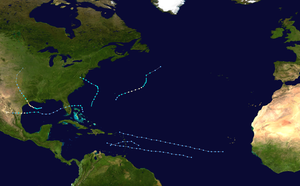| Timeline of the 1983 Atlantic hurricane season | |||||
|---|---|---|---|---|---|
 Season summary map | |||||
| Season boundaries | |||||
| First system formed | July 23, 1983 | ||||
| Last system dissipated | September 30, 1983 | ||||
| Strongest system | |||||
| Name | Alicia | ||||
| Maximum winds | 115 mph (185 km/h) (1-minute sustained) | ||||
| Lowest pressure | 962 mbar (hPa; 28.41 inHg) | ||||
| Longest lasting system | |||||
| Name | Barry | ||||
| Duration | 6 days | ||||
| |||||
The 1983 Atlantic hurricane season was an event in the annual tropical cyclone season in the north Atlantic Ocean. It was the least active Atlantic hurricane season in 53 years, during which four storms formed.[1] The season officially began on June 1, 1983 and ended November 30, 1983. These dates, adopted by convention, historically describe the period in each year when most systems form.[2] The first named storm, Hurricane Alicia, formed on August 15. The last storm of the season, Tropical Storm Dean, dissipated on September 30.
This season produced seven tropical depressions, of which four became named storms; three attained hurricane status, of which one became a major hurricane, a storm that ranks as a Category 3 or higher on the Saffir–Simpson scale.[3] The most notable storm in 1983 was Hurricane Alicia, which killed 21 people and caused $2.6 billion (1983 USD; $5.6 billion 2008 USD) in damages, making it the costliest storm, at the time, in Texas history.[4] As a result of its intensity, the name Alicia was subsequently retired from reuse in the North Atlantic by the World Meteorological Organization.[5] Another notable storm, Hurricane Barry, made landfall on Florida as a tropical storm, then, after crossing into the Gulf of Mexico crossing, strengthened into a weak Category 1 hurricane that traveled almost due west across the Gulf before making landfall in extreme northern Mexico.[6]
This timeline documents tropical cyclone formations, strengthening, weakening, landfalls, extratropical transitions, and dissipations during the season. It includes information that was not released throughout the season, meaning that data from post-storm reviews by the National Hurricane Center, such as a storm that was not initially warned upon, has been included.
By convention, meteorologists one time zone when issuing forecasts and making observations: Coordinated Universal Time (UTC), and also use the 24-hour clock (where 00:00 = midnight UTC).[7] In this time line, all information is listed by UTC first with the respective local time included in parentheses.
- ^ John Arnold (1983-11-30). "Hurricane season ends weakly". The Philadelphia Inquirer. Retrieved 2007-12-16.
- ^ Dorst, Neal (June 1, 2018). "Hurricane Season Information". Frequently Asked Questions About Hurricanes. Miami, Florida: NOAA Atlantic Oceanographic and Meteorological Laboratory. Retrieved June 29, 2020.
- ^ NHC Hurricane Research Division (2006-02-17). "Atlantic hurricane best track ("HURDAT")". National Oceanic and Atmospheric Administration. Archived from the original on 2008-09-16. Retrieved 2008-11-03.
- ^ National Hurricane Center (1986). "Hurricane Alicia Preliminary Report Page:2". National Hurricane Center. Retrieved 2008-11-20.
- ^ "Tropical Cyclone Naming History and Retired Names". miami, Florida: NOAA National Hurricane Center. Retrieved July 10, 2020.
- ^ National Hurricane Center (1986). "Hurricane Barry Preliminary Report Page:5". National Hurricane Center. Retrieved 2008-11-20.
- ^ "Understanding the Date/Time Stamps". miami, Florida: NOAA National Hurricane Center. Retrieved July 10, 2020.